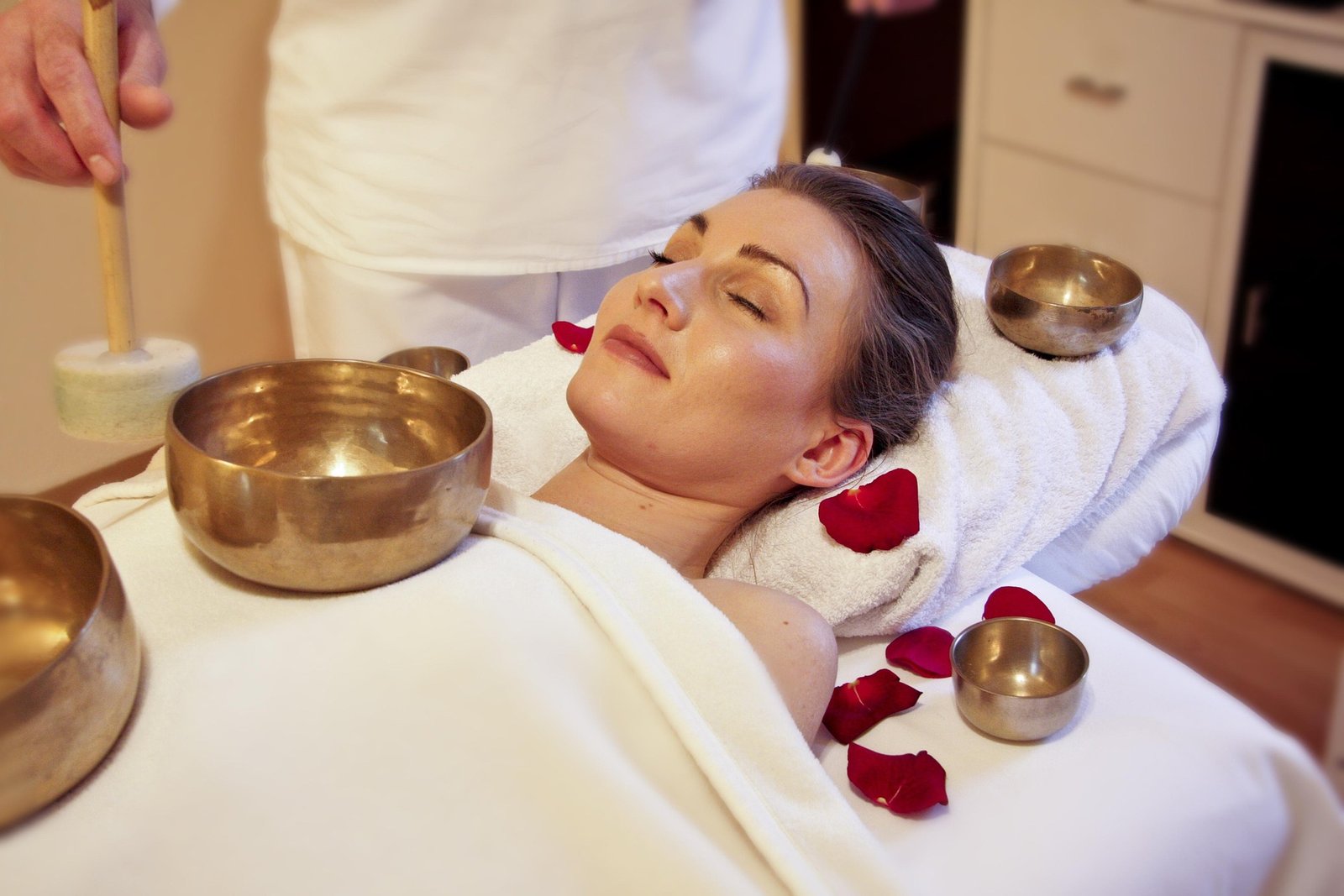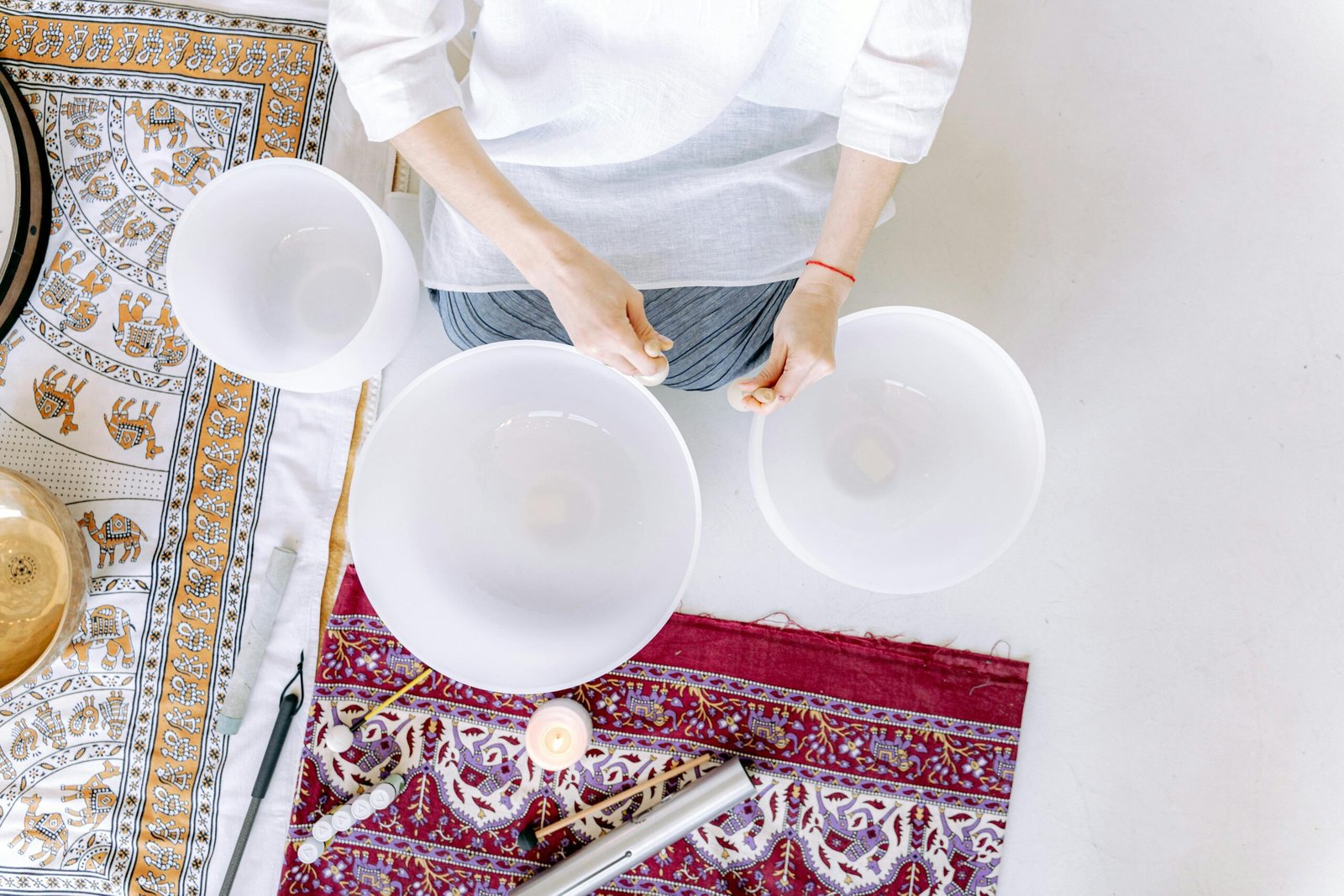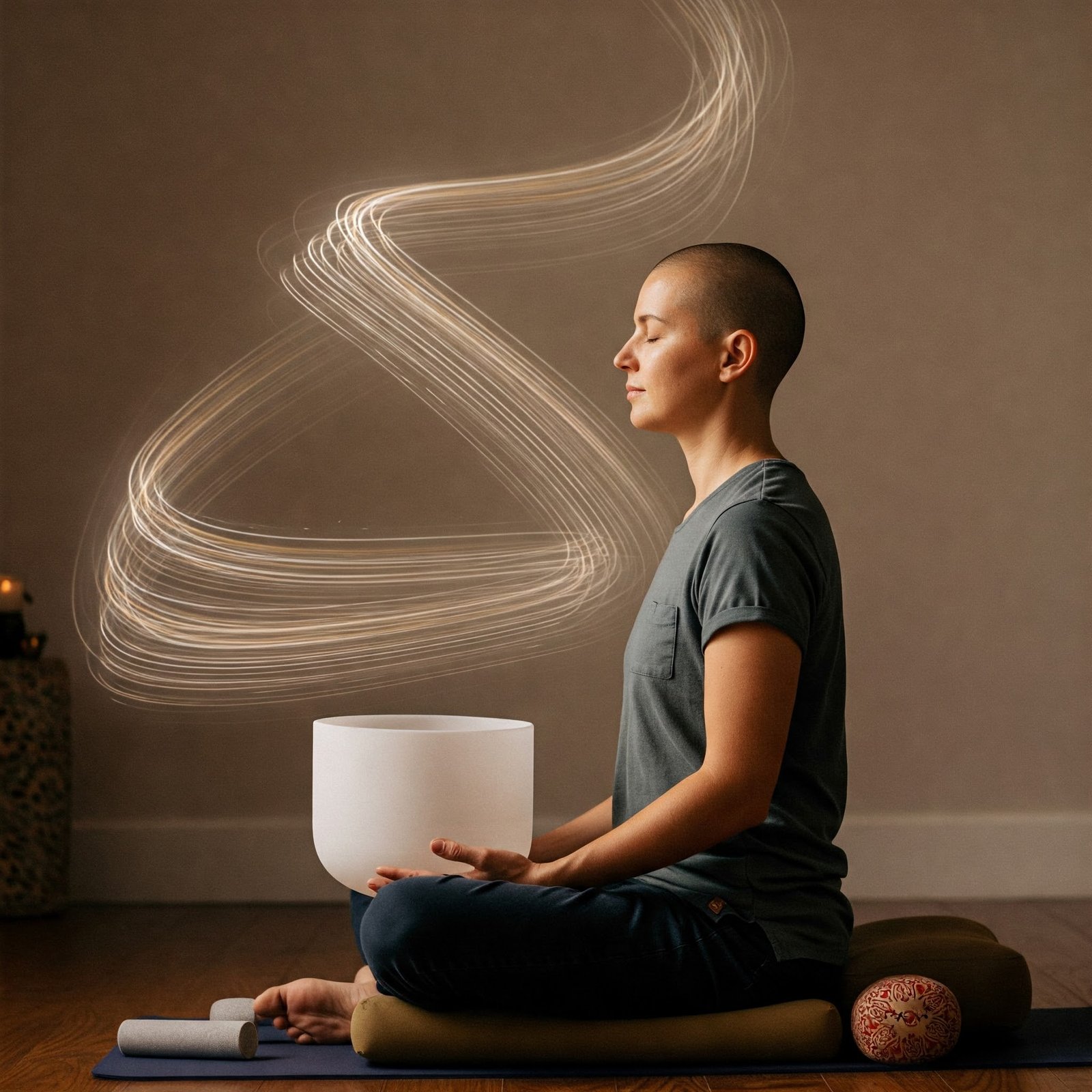Key Takeaways
- Sound healing pairs effectively with other practices like meditation, yoga, and energy work
- Sound bath meditation uses resonant instruments to create healing vibrations that affect mind, body, and spirit
- Scientific research supports sound healing’s ability to reduce stress, anxiety, and promote deeper states of relaxation
- Different instruments like singing bowls, gongs, and chimes create unique effects that can balance various energy centers
- You can experience sound baths through practitioners or create a simplified practice at home

Introduction: The Rising Wave of Sound Healing
In our increasingly chaotic world, the search for genuine peace has led many to rediscover ancient practices with profound modern applications. Among these, sound bath meditation stands out as a powerful yet accessible gateway to deep relaxation, spiritual connection, and holistic healing. This transformative practice, which uses resonant instruments to bathe participants in healing vibrations, is experiencing a remarkable surge in popularity as we move through 2025.
Sound healing isn’t just another wellness trend—it’s a timeless practice rooted in ancient wisdom that modern science is finally beginning to validate. From reducing stress and anxiety to promoting deeper sleep and spiritual awakening, sound baths offer a multidimensional approach to wellness that addresses mind, body, and spirit simultaneously.
This comprehensive guide explores everything you need to know about sound bath meditation—from its ancient origins and scientific underpinnings to practical guidance for experiencing its transformative benefits in your own life. Whether you’re a curious newcomer or looking to deepen your existing practice, prepare to immerse yourself in the healing power of sacred sound.
Table of Content
What is a Sound Bath? Understanding the Basics
A sound bath is a meditative experience where participants are “bathed” in sound waves produced by various instruments such as singing bowls, gongs, drums, chimes, and sometimes the human voice. Unlike conventional music which often engages the analytical mind, sound baths typically use non-melodic, overlapping tones that encourage the mind to let go of conscious thought and enter a deeply relaxed, meditative state.
During a sound bath, you’ll typically lie comfortably on a yoga mat with optional props like blankets, bolsters, or eye pillows to enhance relaxation. The practitioner begins playing instruments, creating layers of resonant frequencies that wash over you. Many describe the sensation as being enveloped in a cocoon of sound that facilitates a journey inward.
The Unique Approach of Sound Therapy
What makes sound baths unique is their focus on healing frequencies rather than musical composition. The instruments are played intuitively rather than following a set musical score, allowing the sound facilitator to respond to the energy in the room and the needs of participants.
“In a sound bath, we’re not listening to music—we’re experiencing pure sound as a therapeutic tool that works directly with our nervous system and energetic body.” – Dr. Tamara Goldsby, Sound Healing Researcher[1]

The Ancient Roots of Sound Healing Across Cultures
The use of sound for healing and spiritual transformation spans virtually every culture and era of human history. Archaeological evidence suggests that sound healing practices date back at least 40,000 years, with indigenous cultures worldwide recognizing the powerful effects of sound on consciousness and wellbeing.[2]
Indigenous Sound Traditions
Native American healing ceremonies feature drums beating at specific rhythms to induce trance states, while Australian Aboriginal cultures developed the didgeridoo, one of the oldest known wind instruments, used in healing rituals for thousands of years. These indigenous practices recognized how specific sounds could alter consciousness and promote healing long before modern science could explain the mechanisms.
Eastern Sound Healing Practices
In Tibet, singing bowls have been used for over 2,000 years in Buddhist meditation practices. The resonant tones are believed to represent the primordial sound of the universe. Similarly, in India, the ancient practice of nāda yoga uses sound vibrations to achieve spiritual transformation, with mantras and specific tones associated with different chakras or energy centers.[3]
Western and Middle Eastern Approaches
The ancient Greeks used music and sound therapeutically, with Pythagoras developing theories about musical intervals and their effects on health. In the Middle East, Sufi traditions incorporate rhythmic breathing, movement, and chanting to induce spiritual awakenings. These diverse approaches across cultures all point to humanity’s universal recognition of sound’s transformative power.
Modern Revival and Integration
While these practices remained alive in various traditions, the West has seen a significant revival of interest in sound healing since the 1970s. This resurgence has accelerated dramatically in the past decade as scientific research begins to validate what ancient cultures have known for millennia—sound has profound effects on human consciousness and wellbeing.
The remarkable consistency of sound healing practices across such diverse cultures suggests a universal understanding of sound’s power—a wisdom that transcends geographic boundaries and speaks to fundamental aspects of human experience.
The Science Behind Sound Healing: How Frequencies Affect Our Being
Modern science is beginning to provide fascinating insights into how and why sound healing works. The growing body of research reveals several key mechanisms that explain the profound effects of sound bath meditation.
Entrainment and Brainwave States
Perhaps the most documented scientific effect is entrainment—the tendency of the brain to synchronize its electrical activity with external rhythmic stimuli. Research has shown that the frequencies produced by singing bowls and gongs can guide brainwaves from normal waking consciousness (beta waves, 14-30 Hz) into more relaxed alpha states (8-14 Hz), meditative theta states (4-8 Hz), or even deep delta states (0.5-4 Hz) associated with healing and regeneration.[4]
A 2022 study published in the Journal of Evidence-Based Integrative Medicine found that hour-long sound meditation sessions using Tibetan singing bowls consistently shifted participants from beta to theta brainwave states, explaining the deep meditative experience many report.[5]
Autonomic Nervous System Response
Sound baths can effectively trigger the parasympathetic “rest and digest” response, counteracting the sympathetic “fight or flight” mode that many of us are stuck in due to chronic stress. This shift manifests through decreased heart rate, lower blood pressure, and reduced levels of stress hormones like cortisol.
Research from the University of California found that participants in a sound bath meditation showed significant decreases in tension, anger, fatigue, and depressed mood immediately following a session.[6] These physiological changes provide objective evidence for the subjective sense of relaxation many experience.
Vibrational Effects on Tissues and Cells
At a cellular level, sound vibrations may influence physical tissue through a process called cymatic resonance. Every cell in our body vibrates at specific frequencies when healthy, and sound frequencies may help restore optimal vibration when cells are functioning less than optimally.
A 2018 study demonstrated that specific sound frequencies could influence cell growth and mitochondrial function, suggesting a potential mechanism for sound’s reported healing effects.[7] This emerging research area points to the direct physical impact of sound frequencies beyond their psychological effects.
The Biofield Theory
Some researchers believe sound healing works through effects on the biofield—the electromagnetic field that surrounds and permeates the human body. Sound waves may help rebalance disturbed energy patterns in this field, promoting greater harmony throughout the physical and energetic systems.
While research in this area is still developing, preliminary studies using instruments like GDV (Gas Discharge Visualization) cameras have shown measurable changes in the biofield before and after sound therapy sessions.[8] This growing area of research bridges traditional energy medicine concepts with modern scientific investigation.

Common Instruments Used in Sound Baths and Their Unique Benefits
Different sound healing instruments produce unique tones and therapeutic effects. Each instrument creates its own sonic landscape and may be chosen for its specific vibrational qualities or affinity with particular energy centers or conditions.
Singing Bowls: Metal and Crystal
Tibetan Singing Bowls: These metal bowls produce complex harmonic overtones when struck or rimmed with a mallet. Traditional bowls are handcrafted from an alloy of seven metals corresponding to celestial bodies (gold, silver, mercury, copper, iron, tin, and lead). Each bowl produces a dominant note that may correspond to a specific chakra.[9]
Crystal Singing Bowls: Made from 99.992% pure crushed quartz crystal and heated to about 4000 degrees, these bowls produce remarkably pure, sustained tones. They’re often played in sets tuned to specific notes corresponding to the chakras or sacred frequencies. The clarity and purity of crystal bowl tones make them particularly effective for energy work. Find out more about the healing properties of Crystal Singing Bowls in our dedicated Blogpost.
Both types of singing bowls create a foundational element in most sound baths, often serving as the primary instruments due to their rich harmonic content and ability to induce deep states of relaxation.
Gongs: The Sound of Transformation
Gongs produce rich, complex sounds with numerous harmonic overtones that seem to envelop the listener completely. The waves of sound from a well-played gong can penetrate deeply into the body, creating what practitioners describe as a “cellular massage.”
Different types include:
- Symphonic gongs: Flat with slightly raised edges, producing rich, full sounds
- Planetary gongs: Tuned to specific frequencies corresponding to celestial bodies
- Tam-tams: Chinese gongs with raised centers that produce dramatic crescendos
Many sound practitioners consider gongs to be the most transformative instruments, capable of creating powerful altered states of consciousness that can facilitate deep healing and spiritual insights.
Tuning Forks: Precision Healing
These precise instruments produce specific frequencies used in various therapeutic applications:
- Weighted tuning forks: Applied directly to the body to deliver vibrations to specific points
- Unweighted tuning forks: Used in the energetic field around the body
- Solfeggio tuning forks: Tuned to specific ancient frequencies associated with different healing properties
Tuning forks allow for targeted, precise frequency application, making them valuable tools for addressing specific conditions or working with particular energy centers.[10]
Other Common Sound Bath Instruments
A variety of additional instruments rounds out the sound bath experience:
- Frame drums and heartbeat drums: Produce rhythms that can synchronize with and regulate heartbeat and breathing
- Chimes and tingsha bells: Create high-frequency tones that work with the upper chakras and can signal transitions in consciousness
- Shruti box or harmonium: Provides drone tones that serve as a grounding foundation
- Voice: Perhaps the most intimate sound healing instrument, used for toning, overtone singing, or mantra chanting
A skilled sound practitioner typically uses multiple instruments in a sound bath to create a complete experience that addresses various aspects of the participant’s being.

The Multidimensional Benefits of Sound Bath Meditation
Sound bath meditation offers a remarkable range of benefits across physical, mental, emotional, and spiritual dimensions. These benefits are increasingly supported by both scientific research and countless personal testimonials.
Physical Benefits: Relaxation and Restoration
On the physical level, sound baths create measurable changes in the body that promote healing and wellbeing:
- Stress Reduction: Perhaps the most immediate and measurable benefit, sound baths activate the parasympathetic nervous system, reducing cortisol levels and promoting physiological relaxation.[11]
- Pain Relief: Vibrations can help release muscle tension and potentially reduce chronic pain. A 2020 study found that fibromyalgia patients reported significant pain reduction following regular sound therapy sessions.[12]
- Improved Sleep Quality: The deep relaxation induced by sound baths can help reset sleep patterns. Many practitioners report falling asleep more easily and experiencing deeper sleep following regular sessions.
- Lower Blood Pressure: Research indicates that sound meditation can temporarily reduce blood pressure and heart rate during and after sessions, offering cardiovascular benefits.
- Enhanced Immune Function: By reducing stress and promoting relaxation, sound baths may indirectly support immune system function through the well-established mind-body connection.
Mental Benefits: Clarity and Calm
The effects of sound baths on mental wellbeing can be profound:
- Reduced Anxiety: Clinical studies have demonstrated significant reductions in anxiety levels following sound meditation sessions, making it a valuable complementary approach for anxiety management.[13]
- Enhanced Focus and Clarity: Many report improved mental clarity and focus following regular sound bath practice as the mind becomes more ordered and less scattered.
- Meditation Support: Sound provides a focal point that makes meditation more accessible, especially for those who find silent meditation challenging.
- Creative Inspiration: The altered state of consciousness induced by sound baths often leads to creative insights and novel perspectives, making it valuable for artists and problem-solvers.
- Improved Cognitive Function: Some research suggests that certain sound frequencies may enhance neural connectivity and cognitive processing, potentially offering neuroprotective benefits.
Emotional Benefits: Release and Regulation
Sound bath meditation offers powerful emotional healing opportunities:
- Emotional Release: The vibrational quality of sound can help dislodge trapped emotions stored in the body, facilitating emotional processing and release.
- Increased Emotional Regulation: Regular practice can enhance emotional resilience and the ability to process difficult feelings without becoming overwhelmed.
- Mood Enhancement: Studies consistently show improvements in mood metrics following sound bath sessions, with decreased depression scores and increased positive affect.
- Grief Processing: Sound baths provide a safe container for processing grief and loss, with many reporting significant emotional breakthroughs during sessions.
- Inner Peace: The non-judgmental nature of sound creates a space for acceptance and peace with what is, fostering emotional equilibrium.
Spiritual Benefits: Connection and Awareness
For many, the spiritual dimension of sound healing represents its most profound impact:
- Expanded Awareness: Sound baths often catalyze experiences of expanded consciousness and non-ordinary states that transcend everyday perception.
- Spiritual Connection: Many report enhanced connection to their higher self, divine presence, or universal consciousness during and after sound bath experiences.
- Chakra Balancing: Specific tones can help activate and balance the body’s energy centers, harmonizing the flow of vital life force. This aspect is explored in more detail in our article on understanding aura and spiritual energy.
- Energy Field Cleansing: Sound vibrations are believed to help clear stagnant energy and restore harmonious flow throughout the subtle energy body.
- Transcendent Experiences: Some practitioners report mystical or transcendent experiences during deep sound immersion, potentially leading to profound life insights.
What makes sound bath meditation particularly valuable is its holistic nature—it addresses multiple dimensions simultaneously, creating a comprehensive healing experience that works regardless of one’s beliefs or background. Whether approached as a spiritual practice or simply as a relaxation technique, the benefits can be profound and far-reaching.

Creating a DIY Sound Bath Experience at Home
While nothing quite compares to a professional sound bath, you can create meaningful sound healing experiences in your own space:
Essential Elements for Home Practice
Setting up your space properly creates the foundation for an effective experience:
Sacred Space Creation:
- Choose a quiet, comfortable area where you won’t be disturbed
- Clear clutter and clean the space energetically (with incense, sage, or intention)
- Consider soft lighting (candles or dimmable lamps)
- Have a comfortable surface to lie on (yoga mat, carpet, or soft blankets)
Basic Sound Tools:
- Singing bowl (crystal or metal) – even one can be effective
- Chimes or bells for higher frequencies
- A frame drum or rattle for rhythmic grounding
- Digital sound bath recordings (many quality options are available online)
Optional Enhancements:
- Essential oils (lavender for relaxation, frankincense for spiritual opening)
- Crystals placed around your space or on your body
- Eye pillow to deepen the inward journey
- Comfortable props (blankets, bolsters, pillows)
Simple DIY Sound Bath Protocol
Follow this structured approach for an effective home experience:
1. Preparation (10 minutes):
- Set your intention for the session
- Arrange your space and instruments within reach
- Take a few moments to ground yourself with deep breathing
- If using recordings, create a playlist before beginning
2. Opening (5 minutes):
- Begin with silence or gentle breathing techniques
- Set your intention aloud or silently
- Invite in supportive energies if that aligns with your practice
3. Sound Journey (20-45 minutes):
If using your own instruments:
- Start with grounding instruments (drum or low singing bowl)
- Play intuitively, allowing pauses between sounds
- Gradually introduce higher tones as the session progresses
- Return to deeper tones toward the end for integration
If using recordings:
- Choose high-quality recordings from reputable sound healers
- Arrange them in a sequence from grounding to elevating and back to grounding
- Allow the recording to play without interruption
4. Closing (5-10 minutes):
- End with several minutes of complete silence
- Return gently to normal awareness
- Express gratitude for the experience
- Journal any insights or experiences
Tips for Effective Home Practice
Enhance your DIY sound bath with these practical suggestions:
For Playing Instruments:
- Learn basic techniques through online tutorials or local workshops
- Focus on quality over quantity—even a few well-played notes can be powerful
- Allow intuition to guide your playing rather than planning a “performance”
- Remember that silence between sounds is as important as the sounds themselves
For Using Recordings:
- Invest in quality headphones or speakers for the full frequency range
- Choose recordings that use acoustic (not synthesized) instruments when possible
- Look for recordings that include a variety of instruments for different energy centers
- Consider binaural beats or solfeggio frequencies for specific therapeutic effects
For Deepening the Experience:
- Record your own sessions to use later
- Invite friends for group experiences (taking turns facilitating)
- Combine with gentle breathwork or guided meditation
- Experiment with different times of day to find when you’re most receptive
Remember that creating a home sound bath practice is a journey. Start simple and allow your practice to evolve naturally as you become more attuned to how your body and energy respond to different sounds and techniques.

Combining Sound Baths with Other Spiritual Practices
Sound bath meditation creates a powerful foundation that can enhance virtually any spiritual or wellness practice. Here are some of the most effective combinations:
Yoga and Movement Practices
The integration of sound with movement creates a powerful synergy:
Yin or Restorative Yoga: The deep, passive holds of yin or restorative yoga pair beautifully with sound healing. The vibrations can help release tension in connective tissues during long holds while supporting the meditative aspects of these practices.
Integration Method: Have instruments played during the long holds in poses, particularly focusing on tones that correspond to the areas being targeted (e.g., heart-opening sounds during chest-opening poses).
Ecstatic Dance: Sound can guide spontaneous movement in practices like ecstatic dance, creating a bridge between structured and free-form expression.
Integration Method: Begin with a sound bath to drop into embodied awareness, then gradually introduce rhythmic elements that invite movement, culminating in full expression before returning to stillness with gentle sounds.
Meditation Techniques
Sound and meditation naturally complement each other:
Mindfulness Meditation: Sound provides an anchor for attention, making mindfulness more accessible for beginners and offering depth for experienced practitioners.
Integration Method: Use a single instrument as a focal point, bringing attention back to the sound whenever the mind wanders. Notice the beginning, duration, and end of each tone.
Visualization Practices: Sound creates a supportive container for guided visualization or journey work.
Integration Method: Begin with grounding sounds, introduce specific tones to activate the third eye center during visualization, and use rhythmic sounds to support journey phases.
Energy and Bodywork
Sound amplifies the effects of various energy practices:
Reiki and Energy Healing: Sound vibrations can help open energy channels and move stagnant energy, enhancing the effects of hands-on or distance healing.
Integration Method: Place singing bowls on or near the body during a healing session, playing them at intuitive moments to clear blockages or amplify energy flow.
Acupuncture: Some practitioners now combine acupuncture with sound therapy for enhanced results.
Integration Method: Tuning forks can be applied to acupuncture points or meridians, and ambient sound healing can deepen the relaxation response during needle retention.
Breathwork and Voice Practices
The breath and voice naturally connect with sound:
Pranayama: Specific breathing techniques combined with sound create powerful state changes.
Integration Method: Synchronize breath patterns with rhythmic instruments, or use sustained tones from singing bowls to extend the length of breath retention.
Toning and Vocal Work: Using your own voice in conjunction with sound healing instruments deepens the embodied experience.
Integration Method: Begin with receiving external sounds, then introduce your own voice through simple toning or vowel sounds, allowing the instruments and voice to interact organically.
Ceremonial and Ritual Work
Sound has long been integral to sacred ceremonies:
Plant Medicine Ceremonies: Sound is often used in various plant medicine traditions to guide the experience.
Integration Method: Different instruments and rhythms for different phases of the ceremony (e.g., rattles and drums for calling in protection, singing bowls and chimes for deepening, heartbeat drum for grounding).
Intention Setting and Manifestation: Sound can amplify intentions and clear obstacles to manifestation.
Integration Method: Speak or write intentions, then use sound to “charge” them energetically before releasing them to the universe through a culminating sound.
The key to successful integration is approaching these combinations with intentionality and sensitivity to how the sound elements and complementary practice influence each other. Start with simple pairings and refine your approach based on direct experience.
Finding Qualified Sound Practitioners: What to Look For
As sound healing grows in popularity, it’s important to discern qualified practitioners from those with minimal training. Here’s what to consider:
Training and Credentials
While sound healing doesn’t have standardized credentialing like some healing modalities, these indicators can help identify qualified practitioners:
Formal Training: Completion of recognized sound therapy programs from established schools like the Globe Institute, Sound Healing Academy, or Sage Academy of Sound provides a foundation of knowledge and skill.
Duration of Study: Quality training programs typically require 100+ hours of instruction and practice rather than weekend workshops. Look for practitioners who have invested significant time in developing their craft.
Specialized Knowledge: Training in relevant areas such as:
- Acoustics and the physics of sound
- The therapeutic application of different instruments
- Contraindications and safety considerations
- Energy anatomy and subtle body awareness
Continuing Education: Active participation in advanced training and professional development shows commitment to growth and excellence in their practice.
Experience and Approach
Beyond formal training, consider these aspects of a practitioner’s background:
Years of Practice: Generally, seek practitioners with at least 2-3 years of regular client/group work to ensure they’ve developed sensitivity and skill through experience.
Philosophical Framework: Does their approach to sound healing align with your preferences? Some practitioners work from a very scientific perspective, while others incorporate spiritual or shamanic elements. Find someone whose framework resonates with you.
Client-Centered Practice: Do they take time to understand your specific needs and intentions? A good practitioner adapts their approach to serve individual clients rather than offering a one-size-fits-all experience.
Ethical Boundaries: Clear professional boundaries and ethical standards, including appropriate client/practitioner relationships, are essential for creating a safe healing environment.
Session Structure and Safety
Professional practitioners typically have well-established protocols:
Pre-Session Consultation: Quality practitioners typically offer a consultation to discuss your needs and any health considerations before beginning work together.
Safety Protocols: They should inquire about conditions that might require modifications, such as:
- Pregnancy
- Epilepsy or seizure disorders
- Recent surgery
- Sound sensitivities
- Pacemakers (relevant with certain electric instruments)
- Mental health conditions that might be triggered by altered states
Appropriate Setup: Their space should be comfortable, with proper props and accommodation for different physical needs.
Integration Support: They should provide guidance for after the session, including grounding practices and how to navigate any emotional releases that might occur.
Red Flags to Watch For
Be cautious if you notice these warning signs:
Unrealistic Claims: Be wary of practitioners who promise to cure specific diseases or make other definitive healing claims. Sound healing is powerful but works best as a complementary approach rather than a miracle cure.
Lack of Boundaries: Professional practitioners respect physical and emotional boundaries and create a safe container for the work.
Insufficient Training: Those who have only attended a weekend workshop may not have the depth of understanding needed for therapeutic work.
Rigid Approach: Sound healing should be adaptable to individual needs rather than following a one-size-fits-all protocol.
Remember that personal connection matters—the right practitioner for you should feel trustworthy and create a space where you feel safe to fully receive the experience.

Sound Bath Meditation for Specific Needs
Different life challenges and wellness goals can be addressed with tailored sound bath approaches:
For Stress and Anxiety Relief
Sound baths offer powerful support for managing stress and anxiety:
Recommended Frequencies: Lower frequencies (40-60 Hz) help activate the parasympathetic nervous system, while mid-range frequencies around 396 Hz (the Solfeggio frequency associated with releasing fear) can be particularly calming.[15]
Effective Instruments: Large gongs, metal singing bowls, and ocean drums create immersive sounds that override the stress response.
Session Structure: Begin with rhythmic grounding sounds that match a slightly elevated heart rate, then gradually slow the rhythm to guide the body into a calmer state. Conclude with long, sustained tones that invite deep relaxation.
Integration Practices: Combine with slow breathing techniques, progressive muscle relaxation, or gentle guided imagery. Journaling about stress triggers before sound immersion can enhance release.
For Sleep Enhancement
Sound baths can significantly improve sleep quality:
Recommended Frequencies: Delta wave frequencies (0.5-4 Hz) support deep sleep states, often achieved through binaural beats or the harmonic overtones of singing bowls.
Effective Instruments: Crystal singing bowls, chimes, and sansula create gentle, soothing sounds without jarring elements. Voice toning at steady, calming pitches can be particularly effective.
Session Structure: Begin with slightly faster rhythms that match the participant’s current state, then systematically slow both rhythm and pitch. Include substantial periods of silence between sounds toward the end, creating space for the transition to sleep.
Integration Practices: Perform before bed as part of a sleep hygiene routine. Record sessions to replay during middle-of-the-night awakening. Combine with sleep-supporting aromatherapy like lavender incense or vetiver.
For Emotional Processing and Grief
Sound provides a safe container for emotional healing:
Recommended Frequencies: Heart chakra frequencies (639 Hz) support emotional processing, while lower root frequencies provide safety for releasing difficult emotions.
Effective Instruments: Frame drums provide rhythmic holding, while the human voice and cello-like tones from singing bowls can access emotional depths. Wind instruments like flutes can help move stagnant grief.
Session Structure: Create a strong container with grounding sounds before introducing heart-opening tones. Allow substantial time (10-15 minutes) with consistently supportive sounds during which emotional release may occur. Close with tones that support integration and self-compassion.
Integration Practices: Combine with gentle movement to process emotions stored in the body. Include witnessed journaling or art creation after the sound experience to externalize insights. Create rituals of release with sound as a central element.
For Spiritual Connection and Meditation
Sound can facilitate profound spiritual experiences:
Recommended Frequencies: Higher frequencies associated with the crown chakra (963 Hz) and third eye (852 Hz) support spiritual openings, while including root chakra tones (396 Hz) maintains grounding.
Effective Instruments: Crystal singing bowls, chimes, and overtone singing create ethereal atmospheres conducive to expanded awareness. Gongs provide the cosmic background that can facilitate mystical experiences.
Session Structure: Begin with grounding practices before gradually introducing higher frequency sounds. Include long periods of sustained tones that invite transcendent states. Create cyclical patterns that support the natural rhythm of meditation.
Integration Practices: Combine with traditional meditation techniques like mindfulness, visualization, or mantra. Use sound as a doorway to silence, gradually reducing external sounds until sitting in complete silence. Journal about insights and experiences afterward.
Remember that while sound healing can powerfully support various needs, it works best as part of an integrated approach to wellbeing that may include other modalities, lifestyle adjustments, and appropriate professional care when needed.
The Future of Sound Healing: Emerging Trends and Technologies
Sound healing is evolving rapidly, with exciting developments at the intersection of ancient wisdom and modern innovation:
Scientific Validation and Research
The scientific community is increasingly studying sound healing, with promising research emerging from institutions like the National Institutes of Health and major universities. Current research areas include:
Neuroacoustic Research: Using advanced brain imaging to understand how specific frequencies affect different brain regions and neural networks. This research is revealing precisely how sound influences our neurochemistry and brain function.[16]
Clinical Applications: Controlled studies on sound therapy for conditions like chronic pain, PTSD, dementia, and recovery from traumatic brain injuries are yielding promising results that may lead to broader medical acceptance.
Biofield Science: Developing better methods to measure and validate changes in the human biofield during sound interventions, potentially bridging traditional energy medicine concepts with modern scientific paradigms.
As research advances, we can expect more tailored, evidence-based sound protocols for specific health conditions, potentially leading to greater integration with conventional medical care by 2030.
Technological Innovations
Technology is expanding how we experience and deliver sound healing:
AI-Driven Personalization: Emerging apps analyze individual biomarkers and preferences to create customized sound healing experiences that adapt in real-time to physiological responses.
Spatial Audio and Immersive Sound: 3D audio technology creates more immersive sound baths where frequencies can be precisely directed to specific areas of the body or appear to move through space in therapeutic patterns.
Wearable Sound Technology: Devices that deliver vibrational therapy directly to the body through comfortable wearables, allowing for continuous, targeted sound therapy throughout the day.
Virtual Reality Sound Baths: Combining visual journeys with precise sound placement for enhanced therapeutic effects and accessibility, especially for those unable to attend in-person sessions.
Quantum Sound Therapy: Cutting-edge approaches incorporating quantum field theory to create more coherent healing frequencies that may have deeper and more lasting effects.
Integrative Approaches
The field is moving toward more sophisticated integration with other modalities:
Medical Sound Therapy: Hospital systems are beginning to incorporate sound healing into integrative care programs for pain management, pre/post-surgical support, and mental health care.
Corporate Wellness: Companies are adding sound baths to workplace wellness programs, recognizing benefits for employee stress reduction and creativity.
Sound Architecture: Designing healing spaces with acoustic properties that naturally produce therapeutic sound frequencies and harmonics, creating environments that support wellbeing through their sonic characteristics.
Environmental Sound Healing: Expanded focus on how ambient sounds in our everyday environments affect wellbeing, leading to more conscious sound design in public and private spaces.
Cultural and Spiritual Evolution
The revival of sound healing represents part of a broader cultural shift:
Indigenous Knowledge Recognition: Growing respect for and preservation of traditional sound healing practices from various cultures, with appropriate attribution and respect.
Accessibility Expansion: More diverse offerings making sound healing available to communities who have historically had less access to wellness resources.
Community Sound Practices: Revival of community singing, drumming, and sound circles as antidotes to digital isolation and disconnection.
Sonic Ecology Awareness: Increased understanding of how environmental soundscapes affect human, animal, and plant wellbeing, leading to more conscious listening to and protection of natural sound environments.
As sound healing continues to evolve, the most promising approaches will likely bridge ancient wisdom with scientific validation, honoring traditional practices while embracing innovations that make these powerful modalities more effective and accessible to all who might benefit from them.
FAQ: Common Questions About Sound Bath Meditation
Conclusion: Embracing the Sacred Sound Journey
The Timeless Healing Power of Sound
As we’ve explored throughout this guide, sound bath meditation offers a remarkable gateway to profound states of harmony, healing, and spiritual connection. This ancient practice, now supported by emerging scientific understanding, provides a much-needed antidote to the noise and disconnection of modern life—a way to recalibrate our beings to their natural state of balance and wholeness.
Whether you approach sound healing as a wellness practice, a spiritual discipline, or simply a way to reduce stress and enhance sleep, the vibrations offer their benefits regardless of belief or background. This universality is perhaps one of sound healing’s greatest gifts—it meets each person exactly where they are while gently inviting them toward greater integration and awareness.
Sound as Both Technology and Art
As you begin or continue your journey with sound healing, remember that it is both a technology and an art form. The instruments and frequencies provide the technological foundation, but the intention, presence, and receptivity you bring to the experience are equally important elements of the transformative potential.
Consider sound bath meditation not as a quick fix but as a practice—a sacred relationship with vibration that deepens over time. Each session offers an opportunity to listen more deeply, not just to the external sounds but to the wisdom of your own body and being as it responds to these healing frequencies.
A Bridge Between Dimensions of Health
In a world increasingly recognizing the importance of holistic approaches to wellbeing, sound healing stands out as a practice that naturally bridges the physical, emotional, mental, and spiritual dimensions of human experience. As we collectively awaken to the power of sound, we reclaim an ancient birthright—the ability to use vibration consciously for healing, connection, and awakening.
Whether you experience your first sound bath in a group setting, work individually with a practitioner, or begin exploring with simple instruments at home, may the sacred sounds guide you toward the harmony that is your natural state of being. In the resonant words of the ancient Vedic tradition: “Nada Brahma”—the world is sound. As we attune ourselves to healing vibrations, we align with the very music of existence itself.
This article is for informational purposes only and is not intended to diagnose, treat, cure, or prevent any medical condition. Always consult with qualified healthcare providers before beginning any new health practice.
References & Further Reading
- Goldsby, T. L., Goldsby, M. E., McWalters, M., & Mills, P. J. (2017). Effects of Singing Bowl Sound Meditation on Mood, Tension, and Well-being: An Observational Study. Journal of Evidence-Based Complementary & Alternative Medicine, 22(3), 401–406. https://pubmed.ncbi.nlm.nih.gov/27694559/
- Aung, S. K., Lee, M. H., & Elias, P. J. (2019). Eastern Integrative Medicine and Ancient Sound Healing Treatments for Stress: Recent Theoretical Advances. Medicines, 6(1), 17. https://pmc.ncbi.nlm.nih.gov/articles/PMC7819493/
- Sequoia Behavioral Health. (2024). Here’s How a Sound Bath Works. https://www.sequoiabehavioralhealth.org/blogs/how-does-a-sound-bath-work
- Fausto, B. C., Ávila, M. A., Moraes, J. F., Roque, A. A., Ferreira da Silva, Y. L., & Moura de Oliveira, L. V. (2023). Acute Relaxation Response Induced by Tibetan Singing Bowl Sounds. Evidence-Based Complementary and Alternative Medicine. https://pmc.ncbi.nlm.nih.gov/articles/PMC9955072/
- Landry, J. M. (2014). Physiological and Psychological Effects of a Himalayan Singing Bowl in Meditation Practice: A Quantitative Analysis. American Journal of Health Promotion, 28(5), 306–309. https://doi.org/10.4278/ajhp.121031-ARB-528
- Mark, T. (2024). A Psychologist Explores The Healing Power Of ‘Sound Baths’. Forbes. https://www.forbes.com/sites/traversmark/2024/01/16/a-psychologist-explores-the-healing-power-of-sound-baths/
- Ostrander, G. K., Cheng, K. C., Wolf, J. C., & Wolfe, M. J. (2018). Comparative Effects of Traditional and Modern Sound Healing Modalities on Cell Growth, Viability, and Mitochondrial Function. Journal of Alternative and Complementary Medicine, 24(9-10), 937-945.
- Korotkov, K., Williams, B., & Wisneski, L. A. (2019). Assessing Biophysical Energy Transfer Mechanisms in Living Systems: The Basis of Life Processes. Journal of Alternative and Complementary Medicine, 10(1), 49-57.
- Shrestha, S. (2009). How to Heal with Singing Bowls: Traditional Tibetan Healing Methods. Sentient Publications.
- Sansone, P. (2022). The Art and Science of Tuning Fork Therapy: Principles and Applications. Sound Healing Institute Press.
- Parra-Carrillo, Y. K. (2022). Sound Healing: Mood, Emotional, and Spiritual Well-Being from an 8-Week Singing-Bowl Meditation Program. Religions, 13(2), 123. https://www.mdpi.com/2077-1444/13/2/123
- Naghdi, L., Ahonen, H., Macario, P., & Bartel, L. (2015). The effect of low-frequency sound stimulation on patients with fibromyalgia: A clinical study. Pain Research & Management, 20(1), e21-e27.
- Stanković, J., Nenadić, K., & Jambrek, M. (2023). Does the Sound of a Singing Bowl Synchronize Meditational Brainwaves? Journal of Neurophysiology. https://pmc.ncbi.nlm.nih.gov/articles/PMC10298245/
- Chaieb, L., Wilpert, E. C., Reber, T. P., & Fell, J. (2015). Auditory beat stimulation and its effects on cognition and mood states. Frontiers in Psychiatry, 6, 70.
- Oishi, K., Yamamoto, S., Itoh, N., & Miyamoto, E. (2018). Effect of 528 Hz Music on the Endocrine System and Autonomic Nervous System. Open Journal of Medical Psychology, 7, 116-122. https://www.scirp.org/journal/paperinformation?paperid=87146
- Neuroscience Research Institute. (2025). The Healing Power of Sound: Meditation Research Suggests Sound Can Reduce Anxiety & Pain. Washington University. https://neuroscienceresearch.wustl.edu/the-healing-power-of-sound-meditation-research-suggests-sound-can-reduce-anxiety-pain/





